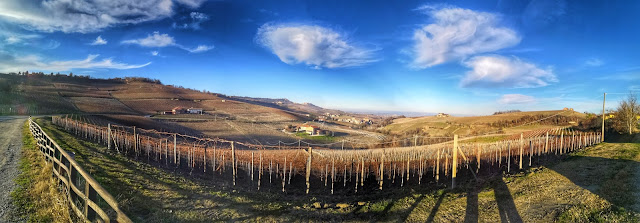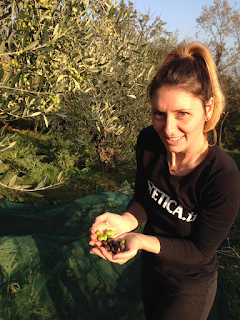In order to spot the places in Italy that the (mostly English speaking) foreigners find interesting enough to visit, just pay attention to the names. They are translated! So you'll have Tuscany, Sicily, Sardinia and... Piedmont as the most visited regions. Then there are the cities: Milan, Rome, Venice, Florence, the Dolomites, the Amalfi Coast. But there must be some exotic sound of Italian language left, something not too difficult to remember, but tasty to pronounce even if you don't speak Italian, so we have Cinque Terre, Sorrento, Pisa, Bologna, Verona and San Marino who people tend to forget is an independent State, just as Vatican.
So why is Piedmont so appealing? Well for the wine of course! I have myself just discovered the endless fields of vineyards that besides producing some of the best wines in the world, are extremely fascinating to see. The view is differently enchanting in all seasons, but somehow I prefer to go in Piedmont in wintertime. My first time was focused on Turin since the city has so much to offer for a whole holiday (from culture, history and art to events and cuisine).
It took Covid-19 to bring me back in wintertime, this time in a whole new perspective. I knew that with the Christmas 2020 lockdown coming up shortly, all the museums, castles, galleries are going to be closed and events canceled. Big churches were the only ones open, but in small villages not even.
 |
| Monforte d'Alba |
So how to plan a short pre-Christmas vacation in wintertime (when you'd rather stay indoors because of the cold) and pandemic time (when everything is closed)?! The weather forecast wasn't helping at all: rains, fog and bad weather to come - they said. So where on earth am I going, right? NOT. There is a Latin proverb "Audentes fortuna iuvat", meaning fortune favors the bold. So despite the whole situation being quite discouraging, I didn't want to interrupt the tradition of a little pre-Christmas trip, which happens to be my birthday trip as well! To be honest it was his idea and The tradition started 8 years ago, when we met. Who am I talking about? Well the Ambassador, of course, in other words my soul mate. But that's another very long story and I am going out of the topic.
 |
| Guarene |
Ok, so in a day I decide and pack up, following day on the road. And that's exactly what this trip is going to be: on the road! You better have a comfortable car, possibly with a sliding roof and warmer seats. Destination LANGHE and MONFERRATO. Plenty of panorama everywhere and a route full of small towns to visit. Yes, because if you're not visiting any insides (museums, castles etc), it is going to be quite a short visit of outdoor landscape and you'll quickly reach a certain (30+) number of places in just 3-4 days of journey, not even enough time to remember all the names! In each you'll stop to observe the panorama, read the information about relevant facts, take a photo, grab a drink or lunch and take a stroll where possible. A perfect place for a layover in the middle of it all is the city of Asti.
 |
| Belvedere Langhe |
So going north you'll explore the lands of Monferrato dynasty, lots of little hills that look like Panettone and hidden jewels in the mountains like the Sacred Mount of Crea where there are 23 chapels hidden in the woods on the way to the sanctuary founded around AD 350.
 |
| Sacred Mount Crea |
Religion linked there is another hidden place where I happened to arrive in a perfect moment: at sunset! Million colors were changing above the mountains layers and reflecting the warm light on the legendary Abbey of Vezzolano. Legendary not because we all know about it, but because according to the legend, the foundation of the abbey dates to Charlemagne times. "Here he would be hunting , in the year AD 773, when three skeletons appeared to him from the tomb. He thus decided to build an abbey here entitled to the Virgin Mary. Historically, the abbey most likely existed in Lombard times, and later was enlarged thanks to rich donations. In the 10th century it was destroyed by the Saracens. In AD 1002 it was donated by the King Arduin of Italy to Oddo of Bruzolo, whose heirs gave it to the prepository of Vezzolano. The abbey was the seat of a religious community until the early 19th century, when it was suppressed during the Napoleonic invasion of Italy."
 |
| Abbey of Vezzolano |
Going south in the area of Langhe, there are countless little towns on the top of the hill and every single one of them has a castle and a church. Many castles in the region became private property or hotels, so it is impossible to visit them. But the choice is wide and one of my favorites was the Castle of Govone. It used to be a possession of the Italian royal family of Savoia and it is now hosting offices of municipality. Imagine your daily working routine in a castle with a million dollar 360 view on Langhe!!!
 |
| Panorama from the Castle of Govone |
Then there is a huge oversized bench just outside the walls of Monforte d'Alba. What's the deal with these benches?! Of course there is a WHY! We'll go back to 2010 and ask the American designer Chris Bangle about it. So the first Big Red Bench #1 was placed in 2010 specifically in Langhe area of Piedmont with the purpose of observing the infinite beauty with childish mesmerized eyes! I told you it was worth it! It became so trendy that the number of these benches is constantly growing (+100 in whole Italy!!!).
 |
| Monforte d'Alba |
But even just driving around in the Langhe it is breathtaking how many vineyard fields are there! As far as the eye can see and beyond! Big houses with cellars, vineyard all around it and small house for the working tools in the middle of the field. Multiply that for every hill, color, altitude and you'll have an idea of what I am talking about. Here I am remembering Barolo, the only little town sited in the valley, instead on the top of the hill. Yes, it gave the name to the famous wine.
Then there are some bigger towns (the above mentioned are all between 1500 - 3500 inhabitants) as Asti, Alba and Vercelli in the area, definitely worth visiting. Asti is special for having an yearly Palio, less known than Sienna one. It is also a quite subversive place, I've found: there is a city government office titled to Mandela and there is an Ex desecrated church, today property of Municipality of Asti, which got turned into a punk lounge bar with fluo lights and punk-rock music!
 |
| Asti |
 |
| Casale Monferrato |
While approaching Vercelli, foggy sunset was on the way. Did I mention that I got 2 days of bright sun and a third day with a shy fog that was clearing up just in the right moments: when I was visiting something and taking photos. That much about the weather forecast! It was even quite mysterious to start the day on the road with visibility zero, like in the middle of a cloud and then see the landscape unwrapping in front of your eyes, to culminate in a rose, orange and purple misty sunset with a fog all around it.

But Vercelli, besides being such a young city (where were the adults?! Was it because I happened to be there on a Friday night?), the main treasure is the Basilica of Saint Andrea. Monumental from every angle, gothic and red - visiting is a must. Especially the internal cloister. There is a Synagogue as well in town. I've found out that the massive old hospital was built because Vercelli happened to be on "via francigena", an ancient road and pilgrims route to Rome and Apulia, originating in France.
 |
| Vercelli |
In Alba I bought the most expensive loaf of bread in my life: 5€! But man if it was tasty and lasted long! And for the chocolate gourmands, in case you didn't know, Alba is home to FERRERO! (I risked applying for a job, just to have chocolate 24/7!). I also found a new pair of wings under the Christmas tree on the main square.
 |
| Alba |
And that is my last exploring "flight" for this curious (so to say) 2020. Still had a blast, but world balance is changing. Fasten your seatbelts for 2021, will ya? CHEERS












































